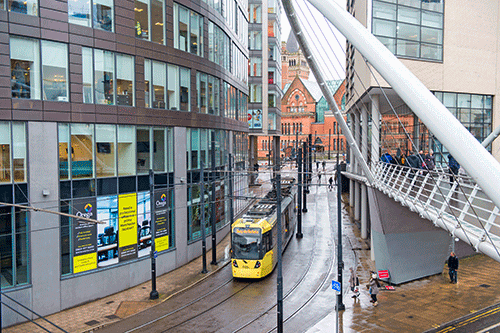 Read the peer reviews for this article
Read the peer reviews for this article
Apparently, the future might already be the past - or at least that version of the future where we revel in a transport utopia.
Writing a briefing paper in 2012, Louise Butcher, a transport policy specialist at the House of Commons, began bluntly: “The heyday of light rail in the UK was in the 1980s/1990s when systems were planned for dozens of areas across the country. For one reason or another most of these failed to materialise.”
There was a time around the turn of the century when it seemed no self-respecting UK city was without an artist’s impression of a tram gliding through streets. By now they were expected to be an everyday reality in Liverpool, South Hampshire and Leeds. But around 2004, one after another, they fell by the wayside, usually after years of development. In the case of Leeds, £40 million had been spent on consultants and land purchase by the time Government pulled the plug, citing rising costs.
However, systems have opened in Nottingham and Edinburgh. Broadly speaking passenger numbers have been strong, although both projects ran behind their initial schedule. Again, more headlines were generated in the Scottish capital by the costs - despite the line being truncated, an original cost estimate of £375m had risen to more than £500m by the time the contracts were signed, and ultimately to £776m when the project was completed. An inquiry into what happened is likely to consider millions of documents.
Elaine Greenwood is the head of sales for rail consultant ESG. Before that, she was responsible for hundreds of millions of pounds of light rail contracts at Bombardier Transportation. When we meet for a coffee, her passion for the topic is obvious - her cup goes almost untouched as we discuss the view from her front row seat, watching the rise (and apparent stall) of the UK’s flirtation with trams. I’d expected costs to be the first thing we discussed, but it is another ‘c’ word on her mind… culture.
“There is a serious lack of understanding and knowledge of light rail in the UK. What generally happens is even though people ask for consultants to help, they end up with a heavy rail consultant, trying to apply the principles of heavy rail to light rail. Until people realise there is a real fundamental difference, then it’s a problem.
“If you are building a brand new network, put the vehicle to one side - that’s the easy bit generally. The difficult bit is having the rails in the ground, because in a city centre they are going to run over utilities. The companies come forward and say ‘you can’t build there because of our equipment’. It’s just a way of getting new equipment on the expense of someone else, so all of those costs get attributed to the light rail network.
“You need a complicated act of Parliament where anyone who owns any piece of land on your route, you have to contact. It’s not about the interruption to your life, it’s about you having the right to say ‘I don’t want it to run there’. And people will say that - not because they mean it, but because they think they can get some money. The Transport & Works Act Order is a complicated and expensive process... it’s all part of the whole cost of the project. ‘It’s too expensive’ is what you always get. It’s not. It’s the way it is done.”
Our conversation is peppered with examples where Greenwood believes mistakes were made, but not shared with others as a learning process: “There’s embarrassment, or it is disguised as confidential information.”
For example, a terminus on one city system has ended up isolated after the tower blocks it was designed to serve were demolished before it opened.
“During the build, no one had told them those flats were going to be demolished,” she says.
Another city planned to use bespoke vehicles because a more standard-sized solution wouldn’t fit around one proposed corner.
“So, change the bloody corner! Move it somewhere else. All that does is cause the whole project to rise in cost.”
But Greenwood also has praise for London’s Docklands system and for Manchester, which save money and take the responsibility for integration between track, equipment and vehicles, managing extension projects themselves and cutting any risk premium that a financier might attach. So, does she believe light rail still has potential in the UK?
“I don’t think light rail is the answer to everything. There are places where it shouldn’t be promoted, but where there should be - from an economic point of view, from a transportation point of view - it appalls me that there isn’t one. Leeds is a fine example.”
Following the withdrawal of funding for Leeds’ Supertram project, officials were asked to draw up a trolleybus scheme. But Greenwood’s assertion that people who might use a tram would never use a bus has turned out to be prescient - as this issue of RailReview was going to press, the Leeds Trolleybus scheme was cancelled. The city has now spent around £65m over the best part of two decades, with nothing to show for it. It is apparently the largest European city without a transit system.
Looking abroad, major cities seem able to commission and build light rail much more quickly. In France, some two dozen networks are now open. In Lyon, from two lines opening in 2001 there are now five routes plus an express line to the airport. This is in a city that also boasts a metro.
Greenwood points out the distinct difference on the continent: “Over there, utility companies saying ‘you can’t build there’ would be laughed at in the face. The tram network takes priority. Utility companies are told ‘you have this window of opportunity to get in there and shift your stuff and it’s at your expense, not ours. If it’s not done in that time and you have a problem afterwards, we’ll charge you’.”
What drives that attitude?
“Over there transport networks are important! Mayors are voted for on the state of the tram network. They take it seriously.”
Stephen Joseph, chief executive of the Campaign for Better Transport, reckons that the prospects for the future might be brighter once elected mayors of combined authorities are voted in. Will that be enough to persuade promoters to bring forward schemes?
“It’s a complex process.” He says. “You have to be determined and have money. Multi-year funding deals might help, so you can borrow against those. There will be opportunities, but at the moment expecting Local Enterprise Partnerships to promote light rail is not going to happen.”
Joseph is also quick to point out the utility issue: “We tried to crack that one. It seemed mad to us. The utility people seem to have a lot of power, which doesn’t happen with roads. In roads there is a level of sharing. If you are a local authority, looking at whether you build a road or a tram, you face 100% of the costs of moving utilities for the tram but not for the road… it’s not a level playing field.”
Are there other ways the UK could bring down costs?
“We have to find a way of getting away from gold-plating compared with the continent. Some of that is down to safety. Tram Train has involved breaking every Network Rail gold standard in the book and overwriting them. That’s essential if we’re not going to end up with something that looks and costs very heavy rail.
“We’ve got to move to proportionate risk rather than risks based on standards, because essentially what that does is enshrine very high cost, and that’s a problem for the whole rail industry. Crack that and there is an opportunity to bring down the costs of light rail.”
No doubt that would help anyone contemplating a scheme, but at the end of the day a sizeable capital bill still has to be paid.
“What isn’t clear is where the funding is for new light rail,” continues Joseph. “There are two routes here. You could see the rail budget pay for conversion of existing heavy rail lines to light rail. That has been torpedoed by Network Rail insisting that 100% of the asset’s liability and responsibility was transferred from them - they weren’t prepared to accept 99-year leases or similar. One bridge bash could account for a whole year of highway maintenance budget!
“Nottingham raised money through a workplace parking levy. Would other places consider that for a light rail network? You need that kind of funding mechanism, or some kind of tax incremental finance scheme - for example, where light rail serves a new development and is paid for by the new business rates gained from that development.”
Clearly this sort of approach would require a lot of ‘buy in’ from a range of stakeholders. Let’s assume that’s forthcoming, and that a promoter can bring forward a sensibly costed and funded scheme. Is that enough to make light rail work in this country?
“The final problem is the Government’s demolition of the planning process. If you regard planning as a burden on business and you want sprawl to happen everywhere, you’ll get very light rail-unfriendly developments, be they housing or commercial developments. You end up with less dense developments.”
In other words, there just won’t be the required potential bums on seats along the route to bring about a commercially viable ticket income?
“If your spatial planning says ‘we’re going to have business parks next to motorway junctions that nobody can get to except by car’, and the layout is such that it will be really difficult to serve by light rail, then you won’t get light rail. You won’t have the density to justify it.
“On the other hand, if you have spatial planning that has dense city-based development - where new developments are placed along the tram - you are building up the market for the tram. It’s about having tram-friendly planning and transport policies nationally and locally. A number of places have failed to give buses priority over cars, so the idea they might give light rail priority is unlikely. It’s politically challenging, but pressure over air pollution will impel change.”
Joseph sees the three main obstacles as cost, promoters and income. These may be substantial, but he’s far from pessimistic about a future for light rail in the UK.
“The UK is not an exception. Light rail has worked in contexts like the UK. I’ve done this job long enough to remember when there was only the Blackpool tram! We’ve come a long way since then, but there is a problem with everyone inventing the wheel, which means every system is bespoke.”
To some extent it would be impossible to arrange a UK standard, as our city streets are gloriously varied. However, as Greenwood points out, there may still be a way for promoters to help themselves when it comes to the cost of the vehicles, with all the main manufacturers providing vehicles around 40 metres long, 2.65 metres wide and with 100% low floors.
“Use that as the basis. All manufacturers work on a minimum order of 20. Order less and the fixed costs go up. Order more and they come down. If something is in production, can you buy more? Don’t build a new vehicle - really really don’t!”
In September 2011 (some months before Louise Butcher wrote her paper), the Conservative/Liberal Democrat Coalition Government published a rail review paper entitled Green Light for Light Rail.
At that time, the number of passenger journeys made across the country’s light rail networks was just short of 200 million every year - a record level. Now it has reached 250 million a year, some 2.7% of all public transport journeys. The Government acknowledged the high capital costs of tram networks, commenting it was not often seen as “an affordable option for local transport authorities”.
Then Transport Minister Norman Baker made very positive noises: “Light rail is good for passengers, good for local economics, good for the local environment, and it’s a mode of public transport that passengers really enjoy using. That is why I’m committed to doing everything we can to bring costs down to make it a viable option for more communities.”
The key recommendations were addressed to the industry as a whole - to look at how costs were reduced overseas, and to establish a centre of procurement excellence to advise on best practice.
Enter UK Tram, a trade body that already existed but which was reconstituted to enable it to tackle this new mission, talking with a ‘single voice’ to Government and statutory bodies. It is funded by the industry itself and by the Department for Transport. Its General Manager is James Hammett.
“We have to lobby for light rail with ministers, with Local Enterprise Partnerships. We need to make sure everyone is aware of the benefits light rail can bring,” he says.
So what’s the prize for getting it right?
“Better integrated transport, making journeys easier for people, less pollution by moving that many people with one vehicle in one go. When you get it right, it is hugely rewarding.”
Picking up the point about sharing good (and bad) practice, Hammett adds: “We have an owners and authorities group that is the current owner of the systems. They guide new potential owners on not ‘falling down some of the holes’ that they have previously. They advise on what’s worked for them - what’s been good, what’s not been very good, what they would do differently.
“All the time the industry is changing, so it’s about making sure they are not looking at a model from a few years ago that may not work today. All the systems we have in the UK, if you look at them in fine detail, they are all different. But they all have the same common problems in terms of day-to-day operation and maintenance. A lot of things are still the same, the knowledge will be useful.”
Are people nervous about light rail?
“There have been some bad experiences, and people are cautious. But you have to look at the success stories. We can learn from those that weren’t done quite so well - but even those have turned into success stories in the end. As long as people learn from the mistakes, and that’s what we are here to do.”
UK Tram also looks enviously towards the continent, where Mayors are empowered to make decisions and costs are not all tagged to a system’s development. However, its efforts are geared towards finding other solutions that would contribute towards bringing down the initial capital outlay. It has established a research base at the former MoD depot at Long Marston, and recently ran a competition called Low Impact Light Rail, as a result of which 15 projects have been awarded funding for further study.
According to Hammett, these include developing lightweight track sections that could avoid the need to move utilities altogether, but which could be lifted out for access when required. Catenary could also be made lighter and less obtrusive.
“Birmingham has done a good job of making it lightweight on the city centre extension - it’s not obtrusive on the skyline. There are steps to make that even better in the future,” he says.
Indeed, the Midland Metro will dispense with overhead wires altogether for some sections of its future extensions, taking advantage of new battery technology to power the vehicles. Meanwhile, two of the system’s retired trams are bound for Long Marston, to be used on a test track where these and other innovations can be properly trialled.
Says Hammett: “A decade from now there will be at least another couple of systems in the UK, I am confident of that. There are some cities well down the line looking at possibilities. And while this is going on, the current systems we have are expanding - Birmingham has ten years’ worth of work on new extensions.”
Remarkably, the West Midlands isn’t just home to one team pushing the envelope of light rail, but two. Joseph, who also believes that emerging technology will guide light rail’s story in the future, cites the work being done by the Warwick Manufacturing Group. This is an academic department of Warwick University, working with industry partners with a focus on low carbon mobility. In recent years it has applied its research to road transport, including how to make vehicles lighter and propulsion systems cleaner.
“About four years ago we became aware of what we call very light rail and people trying to work in the area, like the Parry People Mover at Stourbridge,” says Programme Director Nick Mallinson.
The PPM is a lightweight vehicle currently in use as part of a unique ‘in franchise’ trial on the short Stourbridge Town branch. Since its introduction a Sunday service has been operated and passenger figures have risen substantially.
Mallinson explains: “We thought this was an area where we could start transferring technology from road-based vehicles into rail. Typically rail vehicles are heavy, and there is a focus on electrification that brings costs with it. We were saying there must be a way of ‘lightweighting’ the vehicles, and if they can be self-propelled so you don’t need the overhead electrics, then we can make a contribution there.”
Currently the group is moving towards the production of its own railcar. It also intends to establish a research centre and test track, situated alongside a former freight formation in Dudley. This would focus on light and very light rail, plus the structures and signalling required to make it work. It also wants to run courses to create a skilled workforce for the sector.
“We think very light rail is a segment where we can drive the technology and create a new manufacturing sector for the UK,” continues Mallinson. “There are big costs associated with what people currently call light rail. We’re talking about vehicles whose weight will be less than one tonne per linear metre. Their axle loads will be between six and eight tonnes, not 15 to 20 tonnes. It’s really a new class of vehicle.”
A bid has already gone to the DfT to carry out a feasibility study into re-opening the Kemble to Cirencester branch, as an independent feeder to Kemble main line station. Discussions are also taking place with Dudley Metropolitan Borough Council about a shuttle between the popular Black Country Living museum and the Zoo.
“There are a lot of barriers caused by misconceptions,” says Mallinson. “Councillors across the country have been told by conventional rail suppliers that very light rail technology is rocket science, it’s very risky, they shouldn’t go anywhere near it, and they should stick with trusted technology such as trams. Our argument is ‘no it’s not rocket science, it’s already being used in hybrid buses and in heavy trucks’. It’s reliable, and it’s proven.”
The Warwick Manufacturing Group’s confidence is clear. Having recently spent time evaluating a powertrain, it anticipates having a working machine to trial by the end of 2017. By lining up potential re-opening candidates and identifying lines where councils might want to preserve services, WMG’s aim is to work “both ends of the problem” and create a customer base for the vehicle it produces.
“There is a definite market - at the bottom end of the transport pyramid if you like - to connect communities to other railway lines or transport hubs,” concludes Mallinson.
While it is now two years since Edinburgh became the latest ‘new’ system to open, network extensions have begun operating in Nottingham, while Birmingham is also set to build more lines. With the Tram Train trial nearing a start in South Yorkshire, this is still a busy time for the light rail industry. There is a belief that with a change of political landscape and an equal change in regulation, light (and very light) rail has an important role to play in the country’s transport make-up. Just as ‘Supertrams’ replaced the double-deck cars of the Edwardian era, might the future feature a further evolution, where all the fundamental components of a network are rethought?
Greenwood shares that outlook with a condition: “With the right champion and the right impetus maybe we will see more light rail - and that would be good. It needs the right person in the right position. You need someone who understands it. You need a champion at central Government level.”
Hammett is upbeat: “There is a huge amount of potential coming up with HS2 and connectivity. Light rail has a big part to play. It is a good tool for growth and redevelopment.”
That transport utopia could still be on its way.

Although I agree with Elaine Greenwood’s statement that “there is a serious lack of understanding and knowledge of light rail in the UK”, I take a more positive stance on its prospects. I don’t agree that the heyday of light rail in the UK was in the 1980s and 1990s, although this was indeed the period where (in Manchester) the protracted and difficult beginnings started.
Firstly, we should understand what issue is being addressed, and secondly, is light rail the optimum solution? In Manchester there were two run-down lines (to Altrincham and to Bury) that were obsolescent in terms of infrastructure and rolling stock, just at the time the city was contemplating a more familiar metro (the Picc-Vic scheme). Light rail arose as a cheaper way of achieving the metro city centre linkage than a tunnelled metro, and fortunately the two corridors chosen were robust enough to support rail transit. I would contend that this was the right solution for the wrong reasons.
Similarly, in London’s Docklands, light rail was chosen as a cheap way of facilitating the Canary Wharf development, with simple linkage from the periphery of central London at Tower Gateway and from Stratford. As in Manchester, former rail alignments were used. This was way under scale for the job envisaged, but it did start the ball rolling, demonstrating a key strength of light rail - you can keep adding to it incrementally provided that the central core retains sufficient capacity. Both Manchester and Docklands have since required major surgery in the central sections, and in both these cases the rebuild has been nearly as big as the original scheme, yet (interestingly) achieved with far less fuss in terms of planning and funding.
Two themes emerge. Firstly, once a system has been established and its benefits shown, it is far easier to extend it than create a new city startup. More recently, the question starting to be asked is: “What do you want to achieve?” This question was clearly not addressed to the satisfaction of the inspector in the case of the failed Leeds Trolleybus scheme, but it is the key question. The choice of technology is secondary, more a function of potential volumes.
The two key concerns for cities are the economy of the city and social inclusion, defined as the ability of the city to function in terms of access to employment and housing. A further issue concerns the built environment in terms of public space and pollution.
These questions arise in cities where the economy is strong and needs to be sustained (such as London), but also where the regeneration requirement is strong. In London the economic argument justified Crossrail (Europe’s largest metro rail scheme), and the social inclusion argument justified the London Overground East London Line project (a heavy rail scheme).
The choice of light or heavy is a function of potential volumes, although Docklands has demonstrated that light rail can, with the right technology, carry huge volumes. For instance, Docklands carries far more passengers than Liverpool’s Merseyrail system. A far better solution for Merseyside would be replacement of the Merseyrail system by light rail, potentially serving a far wider catchment area and potentially a huge increase in ridership.
Light rail comes with the handicap that it needs new alignments. Heavy rail already has these in place, albeit often grossly underused and in need of replacement. Light rail needs to evolve to capture this opportunity, by adapting itself to run on the main line network as well as on its own alignments and on street (often referred to by the unattractive name of “tram-train”, depicting something rather inferior and certainly slower than a train). Neither needs to be the case, and Network Rail’s digital revolution should change all this by freeing up infrastructure capacity and avoiding the nightmare of fusing to different technologies that needn’t be separate.
Why is this all seen as “too difficult”? It is only difficult if you don’t know how to do it. Cities have not been equipped to promote, fund and develop light rail systems, hence the false starts. Heavy rail is state-procured and comes with structures to deliver service and projects - light rail is not. This is changing, as systems such as Manchester, Nottingham, Birmingham and Docklands have built up strong client teams to procure and deliver light rail without the pain experienced when they first started. The Transport and Works Act planning process is no different for any kind of rail, but learning it every time a system is in prospect is the hard way to do it.
This has recently been augmented by the advent of UK Tram, designed to use the resources in these systems (including lessons learned) and to make this expertise available to new promoters. We should not have to repeat every mistake with every new system, as was the case to some extent in Edinburgh, Main line governance structure such as safely regulation and standards is now in place for light rail, as it has been for years in the heavy rail industry.
There is clearly now a worldwide market for light rail, given the many new and evolving systems. Interestingly the United States - a country that killed off light rail owing to vested interests and corruption in the motor, oil and rubber industries - is now at the forefront in the light rail revolution. Every city wants one.
Light rail has not been an industry in the UK, with all the standards and governance needed at devolved city level to make it a success. But if we add recent successes such as in Edinburgh (once the system opened), in Nottingham and in Birmingham (now with trams in the city centre), there will be more dawns. The question this time is whether the day will follow. This could well be the case with other cities such as Leeds, which surely cannot get this wrong yet again.
US experience suggests that other smaller UK cities with good economies and the need to grow sustainably, such as Bristol and Cambridge, may well join the club of seven UK on-street systems, all of which are developing against economic, social and environmental needs - and did I mention transport, too?

Light rail hasn’t always had a great press in the UK. From infamous overspends to innumerable feasibility studies that never made it off the drawing board, there are plenty of cautionary tales. But look at the facts, and the story of light rail in the UK is one of resurgence. With new technology and favourable political winds, we are entering a new age of light rail.
Travel to any city in Britain where a light rail system is up and running, and you find positive passenger experiences, good revenues for operators, and economic and environmental benefits.
Take Nottingham, which last summer marked the completion of its tram extension - two lines link the city centre to the suburb of Clifton in the south and the Queen’s Medical Centre in the east, carrying up to 23 million passengers a year. At Alstom we know Nottingham well. We led the consortium that designed and built the new infrastructure, and we are now responsible for the operation of all three of the city’s tram lines. The tram connects 80% of Nottingham’s workplaces and seven of its nine park and ride sites, and passengers are voting with their feet. Recent research found 98% satisfaction among the city’s tram passengers.
There is no doubt that light rail is a success in Nottingham. There is no reason why it can’t be successful in other parts of the UK. The conditions are right for more cities to adopt the technology.
Politically, the winds are behind light rail. Devolution in this country is putting power back into the hands of cities and regions. There is more local control over transport and economic priorities, and light rail is a proven solution for both. Housing is under intense pressure, especially the greenbelt. Light rail, designed in the right way, supports denser housing in city centres, moving large numbers of people from home to work so urban centres need not sprawl.
Light rail technology has made great strides. Interactions with existing infrastructure and utilities in cities have been cast as insurmountable problems, but Alstom’s experience in Nottingham is instructive. Our engineers found solutions to slash the impacts of noise and vibration at Nottingham University’s campus, for example. Indeed, from battery-powered trams in Birmingham to South Yorkshire’s tram-train pilot, technological boundaries are being pushed and the humble tram is once again at the cutting edge of transport design.
These are all positive signs, but big obstacles must be overcome if light rail is to realise its potential in Britain. A multitude of bodies must work in partnership to find the right solutions to the complexities of building rail infrastructure in urban environments. Councils, transport authorities, utilities and public bodies need to work together to solve problems in a creative and flexible way. We’ve seen this work in Nottingham - we know it can work elsewhere.
Power needs to be given to local regions to truly take control of their transport networks, and planning restrictions must be eased to create a fast, efficient route from the drawing board to the construction site. Achieve these things, and the prize is great.
Look at Reims, where the tramway carries 42,500 passengers a day. Here APS technology (ground power supply) allows us to preserve the look of the historic city centre with a 2km catenary-free section, while providing fluid operation, high availability and safety. There are no performance compromises against the overhead line on the rest of the 11km line.
Look at Dubai, where our trams offer a red carpet passenger experience, with live passenger information and entertainment systems, and air-conditioning to combat the stifling desert heat.
Or look to Rio de Janiero, where brand new Citadis trams will ferry passengers around the city during the 2016 Olympic Games.
Sales of the Citadis alone tell the story of the resurgence of light rail. Since the year 2000, more than 2,300 light rail vehicles have been sold to 54 cities all over the world. In the British Isles, Dublin has also taken up the technology.
In Europe, the Middle East and South America, light rail is a solution to economic growth and the sustainable development of cities. In the UK, for the first time in a long time, the conditions look right for us to take the driving seat in the new age of light rail.
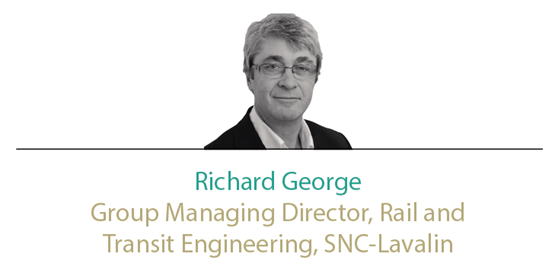
I spent many years in the rail industry believing that light railways in all their forms were: a) Vanity projects for local/regional authorities: and b) Not PROPER railways - they were toy trains, not real ones. In other words, I was part of the exact cultural prejudice that is referred to in the article.
My views have changed radically over the past few years. Firstly, working on the Olympics I saw the Docklands Light Railway in action, and saw its virtues, its flexibility and its business model. Then secondly, I joined SNC-Lavalin, which has a proud history of building and operating light rail transit schemes in Canada. In fact, our teams have now been involved in light railway and tram systems in Australia, France, USA, Kuala Lumpur and the UK, as well as Canada. I am now officially a convert.
I now see such light rail schemes as an integral part of a modern and integrated transport system for an increasingly urbanised world. They lead to growth, redevelopment and reduction in congestion. They are a ‘Good Thing’. The point made by James Hammett of UK Tram is exactly the point I made in a recent speech on HS2 - we must exploit HS2 with light rail to improve overall connectivity. It is a pattern worldwide of growth in High Speed Rail connecting city regions - but then allied to urban transit schemes for the internal connectivity.
The local or regional nature of the investment is the great strength of the light rail transit schemes. It allows bespoke design to fit specific circumstances and (importantly) bespoke financing. The direct relationship between who benefits and who should contribute is much clearer in a local system than a national scheme. So in many respects I think that ‘devolution‘ of powers and devolution of responsibility and accountability will hasten the development of future schemes.
There is always an argument about money - no democratic system is ever going to allow any infrastructure to be built without someone saying: “How much? Why here? Why bother? Not fair!” Globally the challenges look very similar. “Who pays for the utilities works?” is an argument everywhere, with almost universally the same result… the light rail scheme pays, often with a blank cheque required and a long-awaited utility upgrade built into the cheque! The fact is that the closer to the locality the benefits accrue, the easier those arguments are. ‘National Interest’ is always somebody else’s problem.
The important thing is that once they are built, they are used and they are popular. Transport Focus announced at the end of May that customer satisfaction across the six tram networks surveyed in the UK had risen significantly to 92%, and that sort of statistic is replicated across the world. Local flexibility - the ‘horses for courses’ argument - is exactly why I think they are popular and why the future is looking bright.
It seems to me that the discussion in this article about trams, tram-trains, light rail, supertrams, very light rail, etc, is exactly the reason why this type of technology is simply going to become even stronger. It is not a ‘one size fits all’. Light rail can fit the market flexibly, and that’s good for everyone - even old railwaymen like me!

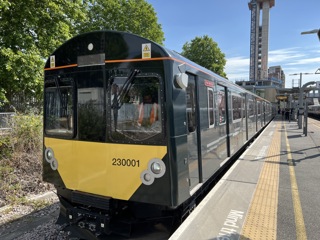
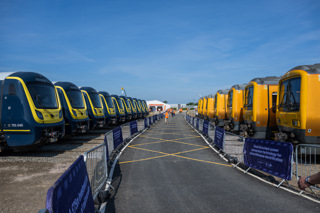
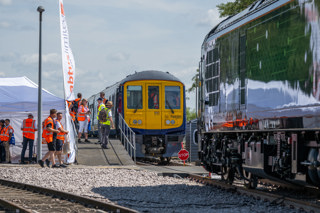













Login to comment
Comments
No comments have been made yet.